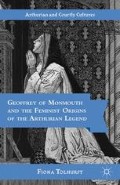Abstract
In the history he called De gestis Britonum, Geoffrey of Monmouth presents the marriage of Queen Igerna and King Uther as founded upon both love and equality, Igerna and Uther’s daughter Anna as a pivotal figure in British history, Queen Ganhumara as King Arturus’s partner in power, Helena as heroic in her resistance to sexual violation, and her nursemaid as heroic in her self-sacrifice. Nevertheless, Geoffrey’s narrative of the British past contains gaps that his early translators Wace and Laȝamon fill in ways that tend to undermine his feminist version of the Arthurian legend. Although female figures in Wace’s roman de Brut and Laȝamon’s Brut have received some scholarly attention, its focus has tended to be narrow. Most studies limit themselves to either Guenevere alone or a small number of female figures, and they tend to focus on either Wace’s or Laȝamon’s poem. 1 However, comparative analysis of all the female figures that appear in the Arthurian sections of both Geoffrey’s history and its early vernacular translations reveals what the two poets have in common: they domesticate the unusual female figures that their predecessor in Arthurian literature created. In Le roman de Brut, Wace complicates the feminist version of the Arthurian legend that he inherited from Geoffrey of Monmouth by expanding the account to which he had access through both the Vulgate and First Variant versions of his source text, yet he undermines feminist legend in two ways.
Access this chapter
Tax calculation will be finalised at checkout
Purchases are for personal use only
Preview
Unable to display preview. Download preview PDF.
Notes
For a study of Guenevere in Wace’s roman de Brut, see Wulf, “A Comparative Study,” in Arthurian Romance, ed. Wolfzettel, pp. 66–78. For studies of Guenevere in Laȝamon’s Brut, see Maureen Fries, “Women, Power, and (the Undermining of) Order in Lawman’s Brut,” Arthuriana 8.3 (1998): 23–32 and
Carole Weinberg, “Victim or Virago: The Construction of Guinevere in Laȝamon’s Brut,” Reading Medieval Studies 35 (2009): 27–43.
For a study of female figures in Le roman de Brut and the Brut, see Le Saux, “Relations familiales,” 217–31. For studies of female figures in the Brut, see Marie-Françoise Alamichel, “The Function and Activities of Women in Laȝamon’s Brut,” in A Wyf Ther Was: Essays in Honour of Paule Mertens-Fonck, ed. Juliette Dor (Liège: University of Liège, 1992), pp. 11–22;
Rosamund Allen, “Female Perspectives in Romance and History,” in Romance in Medieval England, ed. Maldwyn Mills, Jennifer Fellows, and Carol M. Meale (Cambridge, UK: D. S. Brewer, 1991), pp. 133–47;
and Elizabeth J. Bryan, “Laȝamon’s Four Helens: Female Figurations of Nation in the Brut,” Leeds Studies in English n.s. 26 (1995): 63–78.
See the entry for ‘invitare, v.’ meaning ‘to invite, treat, feast, entertain’ and ‘to invite, summon, challenge,’ A Latin Dictionary, ed. Lewis and Short, pp. 996–97 and the entry for ‘mander, v.’ meaning ‘1. Commander, ordonner; 2. Demander,’ Dictionnaire de l’ancien français: le moyen âge, ed. Algirdas Julien Greimas, Trésors du français (Paris: Larousse, 1979; 2nd edn. 1992), p. 365. Based upon these entries, Weiss’s translation of aveit mandees as ‘had invited’ is problematic, for it presents the queen as requesting, rather than requiring, these noblewomen to attend the crown-wearing and is therefore inconsistent with the meaning of RB 10390–94.
Elizabeth A. R. Brown, “Eleanor of Aquitaine Reconsidered: The Woman and Her Seasons,” in Eleanor of Aquitaine: Lord and Lady, ed. Bonnie Wheeler and John Carmi Parsons, The New Middle Ages (New York: Palgrave Macmillan, 2003), p. 9 [1–54].
Hans-Erich Keller, “De l’amour dans le roman de Brut,” in Continuations: Essays on Medieval French Literature and Language in Honor of John L. Grigsby, ed. Norris J. Lacy and Gloria Torrini-Roblin (Birmingham, AL: Summa Publications, 1989), p. 69 [63–81].
Françoise H. M. Le Saux, A Companion to Wace (Cambridge, UK: D. S. Brewer, 2005), p. 7.
D. D. R. Owen, Eleanor of Aquitaine: Queen and Legend (Oxford, UK and Cambridge, MA: Blackwell, 1993), p. 184.
Peggy McCracken, “Scandalizing Desire: Eleanor of Aquitaine and the Chroniclers,” in Eleanor of Aquitaine: Lord and Lady, ed. Bonnie Wheeler and John Carmi Parsons, The New Middle Ages (New York: Palgrave Macmillan, 2003), p. 247 [247–63].
Wace, Le roman de rou, ed. A. J. Holden, 3 vols. (Paris: A. & J. Picard & Co., 1970–73), 1.4, line 31; Le Saux, A Companion, pp. 275–78.
Copyright information
© 2012 Fiona Tolhurst
About this chapter
Cite this chapter
Tolhurst, F. (2012). Complicating and Undermining Feminist Legend in le Roman de Brut . In: Geoffrey of Monmouth and the Feminist Origins of the Arthurian Legend. Arthurian and Courtly Cultures. Palgrave Macmillan, New York. https://doi.org/10.1057/9780230337947_3
Download citation
DOI: https://doi.org/10.1057/9780230337947_3
Publisher Name: Palgrave Macmillan, New York
Print ISBN: 978-1-349-52887-5
Online ISBN: 978-0-230-33794-7
eBook Packages: Palgrave Literature CollectionLiterature, Cultural and Media Studies (R0)

